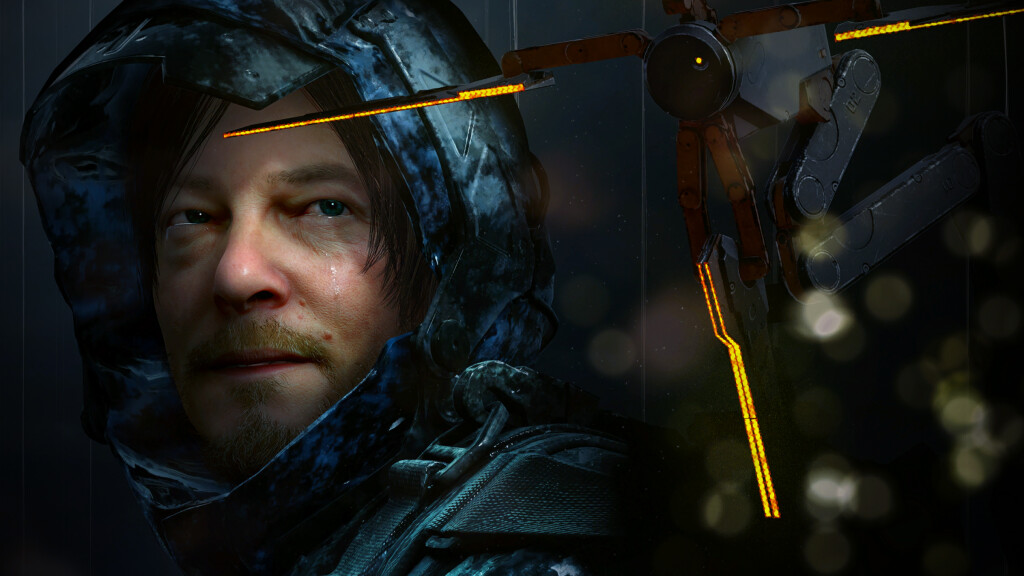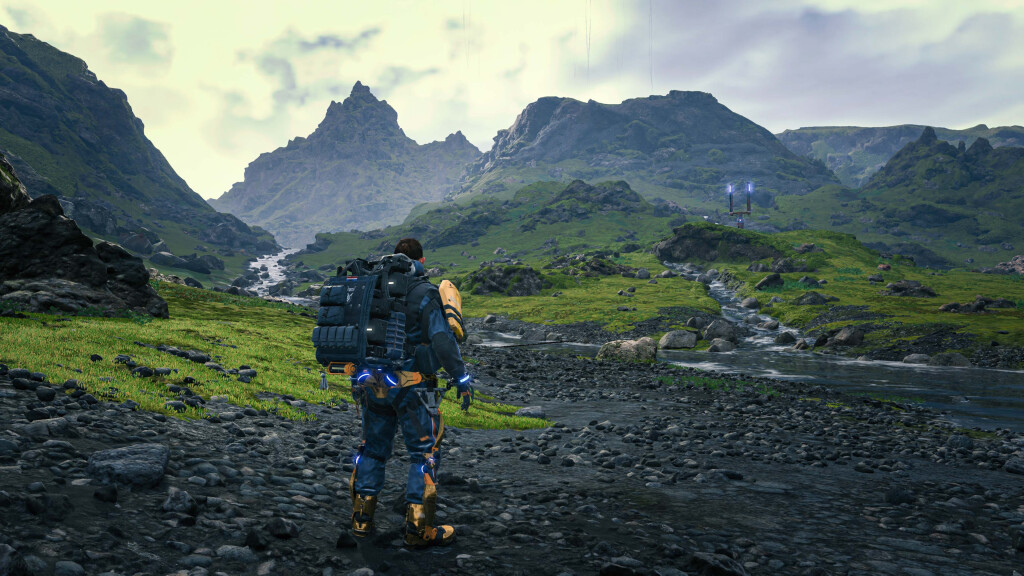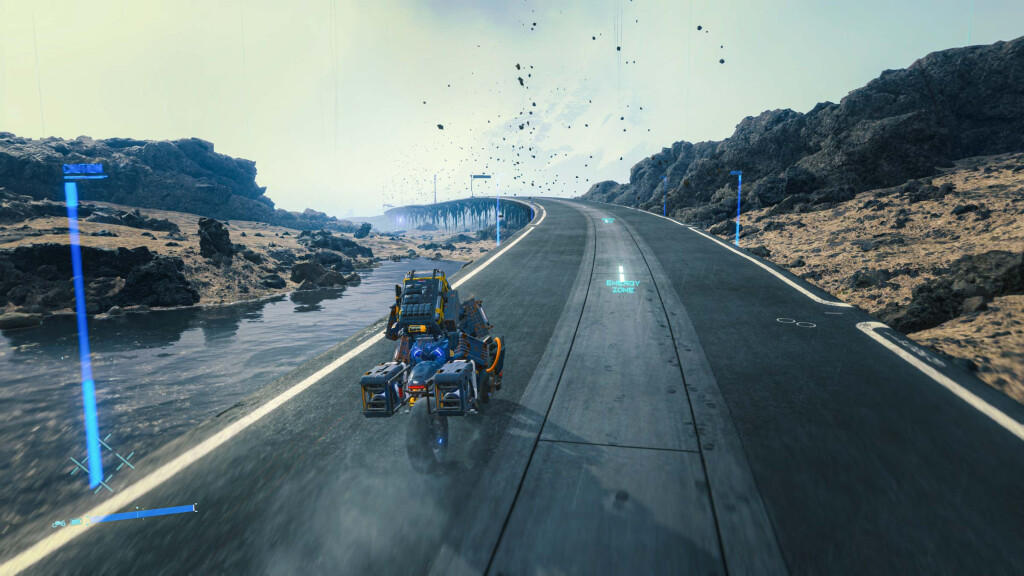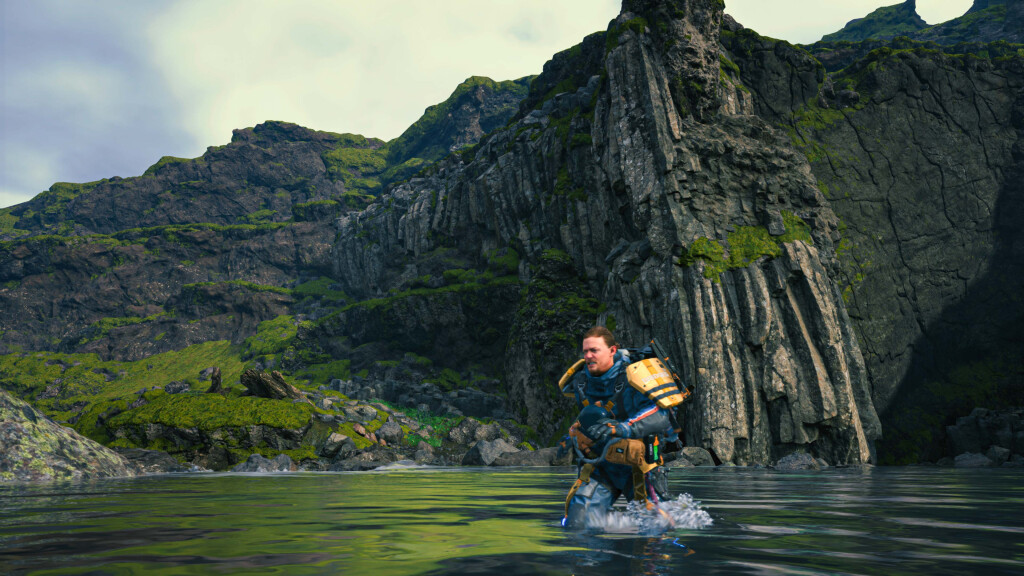Death Stranding
I do love the news that comes out of the gaming conferences, like E3. But also don’t really get too excited until the disc is in, installed, and ready to go. Death Stranding was revealed at E3 2016, and the news had been spruiking this as a Hideo Kojima game and everyone was so excited by that. But that really didn’t mean anything to me – I’d heard of Kojima amongst discussion of other games, but had not played any previous titles. It wasn’t until 2019, when some gameplay was coming out, that my interested really piqued.

Trailers and gameplay footage exposed more – including open world elements, traversal with tools, and a few odd points: these invisible enemies (BTs), a baby strapped to your chest (BB), and peeing in public (because, uh…?).
When the review embargo lifted, I had a skim read, and concluded that this was an incredibly lengthy, at times slow-paced, cinematic story-based action game. And a healthy side dose of “weird”. While some Kojima fans were left underwhelmed, I had an open mind to try something new – including all the weird. After all, when playing any game, you need to accept the lore it creates to immerse yourself in the world.
I was tweeting with a friend after finishing Death Stranding’s lengthy story, and I think I found the words to capture my thoughts:
“It was a game I didn’t ask for, one I didn’t know I wanted, but one that I really needed.”
Even after spending nearly 97 hours earning the Platinum trophy, I’m still not really sure how to describe the game to someone – whether it be another gaming friend yet to play (and how do avoid spoilers?), or my non-gaming partner (how do I say one bit without needing to fill in the entire back story?).
At an incredibly high level, you are Sam Porter Bridges, and are tasked with re-connecting the former United States by making deliveries and rebuilding connections across the country.
Anything beyond that and I feel parts of the game’s story starts to come out. And it’s a story that is best left to be experienced, felt and explored by the player.

Visually, the game is stunningly spectacular. Built using the Decima engine that also powered Horizon: Zero Dawn. The landscapes are equal parts desolate, hostile and curiously beautiful. From lush green mountains to harsh deserts, lunar-like rolling hills and intimidating snow-capped mountains, the Central region in particular seamlessly mixes different landscapes within its map, each offering different challenges for your journey.
At key moments through missions, licensed music is dropped in to your game, predominately by American/Icelandic group Low Roar. This music just feels so right for the gameplay, story and mood created by the game, and has encouraged me to buy a few new albums. Paired with Ludvig Forssell’s eerily beautiful score, acoustically the game keeps you occupied through your journey – from heartrate-increasing aural cues during enemy encounters to touching and swelling orchestral-esque.
Death Stranding isn’t just a game to play casually, but a game to immerse you. Visually, aurally, mentally, emotionally: all of the components working harmoniously together to deliver a deeply unique and satisfying experience. It has the power to draw you in, grab your attention, and keep you present, occupied and relaxed through its marathon duration.
Following this point there are major story-based spoilers. I can’t make my commentary without them, so if you’re wanting to experience Death Stranding for yourself first, go do that and come back later.

It’s a game about being alone. About building meaningful relationships. It’s about love, loss, life, death, the past and the future. It’s about extinction… but it’s also about hope, strength and evolution.
Let’s start with connections. Social media was meant to bring us together, but in 2020, I feel more disconnected than ever. I no longer post on Facebook. Very rarely on Instagram. And do you want to know the most interesting thing about my departure from social media?
No one noticed.
How meaningful are those “friendships” if no one notices my absence? Being originally from Adelaide, moving to Melbourne tasked me with building new connections. But also working in a small office, my Melbourne network is incredibly small. And it gets lonely.
Really lonely.
We do all have busy lives – but busy-ness shouldn’t be an excuse for looking out for someone. Asking “how are you?” and actually wanting to hear the response. Making the effort to hold up to your commitments.
But when you find yourself in too many one-way relationships, it makes you question it all. Why bother?
The combination of feeling invisible, a lack of meaningful connection and loneliness is a catalyst for mental health issues including depression and social anxieties. In late 2019, I was having a bit of a rough time with my own mental health, and Death Stranding came at just the right time for me.
The Marty Cave is my safe place. A place for me to enjoy lengthy periods inside these other worlds, often accompanies by one of my cats, Zack, who loves to keep me company and sleep on my lap. And while I enjoy single player games, the feeling of connection with Death Stranding made me and my contributions be valued.
Death Stranding’s gameplay was cathartic for me, and meditative for my mental state. Yes, the pacing of the narrative is at times slow, but the gameplay itself was thoroughly engaging, and created the opportunity to be mindful and present of my actions and activities.
Through the in-game connections made, I started to see remnants of other player’s games appearing in my own world. A rope to help me up (or down) a hard climb. A bridge across a fast-flowing river. A handy weapon refill during a boss fight. And also the combined efforts of collecting resources to upgrade a road or build a zipline network. Even the landscape changing based on the footsteps of both my journey and of other players’, forming paths and wearing down some of that rocky terrain.
I never see these other players wandering around in the game’s world. The players themselves behind these connections I don’t actually know in real life. But I’m thankful for their efforts, contribution and the connection. Even in such a sparse and seemingly empty open world, I knew I was never really alone. If I were to shout out using the controller’s touch pad, and get a reply from someone, I knew another player was near by in their own game in that exact moment.
We are all working together to help one another reach the same goals.
In an article with Time, Hideo Kojima said: “We’re in an era of individualism. Everyone is fractured. Even on the internet. It’s all connected, all around the world, but everyone is fighting each other.”
Death Stranding gives us a glimpse at the result of meaningful connections with the purpose of helping others. Connections in the game world are made to help one another and to collaborate. To build quality relationships with facilities around the map to get them connected to the network, and share their knowledge, expertise and services. And while I don’t know these strangers who helped my game, I know in turn that my efforts, constructions and gameplay have helped others in their game too. Leaving my constructions behind to give someone else a helping hand.
I’m not a fan of multiplayer games and the “git gud” mentality that can accompany so many online gaming communities. But I found Death Stranding’s passive multiplayer to be an enriching experience to confirm that no matter how lonely I am, no matter how hostile a place I am in, I’m not actually ever alone.

In the final Episodes of Sam’s journey, we learn that the world is on the brink of its sixth Death Stranding – or its sixth mass extinction event.
As the topic of extinction was unfolding, I couldn’t help but think about the current state of the world. Climate change, global warming, more frequent and intense weather events. What are we doing to the planet? What have we already done?
And what are we doing to change this?
Devastating bushfires. Rising sea levels and ice caps melting. Droughts and water shortages. Increasingly violent and severe storms. Some scientists have felt that the actions of the human race (and in turn the effects of climate change) has us on the brink of the next mass extinction.
Through Death Stranding’s climax, we are told that “before each of the Big Five, life rebelled. They fought back. Evolved in order to survive.” And after each extinction, a new life came, stronger and wiser than it was before.
But the first part here is what struck most: before extinction, was a fight. A chance to survive and make a positive change. Amelie put it:
“The extinction isn’t just an ending. It’s an opportunity.”
Through Death Stranding’s gameplay, we make connections. We work towards bringing communities and individuals together – and these strands form the foundation of that fight, that opportunity, to work together, and to think about the impact your actions have on others.
I feel this is in two parts too.
Firstly, the impact your actions have on others in your own real world. This could be family, friends, others in your school, university, workplace, the train, walking down the street, other drivers on the road. How can you make a positive impact with your own actions? How can you be more present in your actions that can complete your goal, as well as showing intentional consideration towards others and their goal?
Secondly, the impact your actions have on the future inhabitants of this world. The next generation. Your kids, or your kid’s kids. What changes can you make now that can have a positive impact on their world.
Just like the connections formed in Death Stranding’s world, we don’t know these future inhabitants. We can’t see them, we can’t talk to them. They can’t see us or talk to us. But they can see what we left behind. They can see the benefits of when we do work together, and how these results positively benefit their experiences.
Looking around you – in game or in real life – Death Stranding has given me an experience that places an emphasis on meaningful connections and positive contributions, and also a glimmer of hope. If we as a whole are facing the next mass extinction, maybe it’s time we (including leaders, “influencers” and politicians) acknowledge that now is the time for us to connect together, to fight back, and to evolve our practices in order to survive. As Kojima has told us in Death Stranding, “tomorrow is in your hands”. What can you do to help tomorrow?